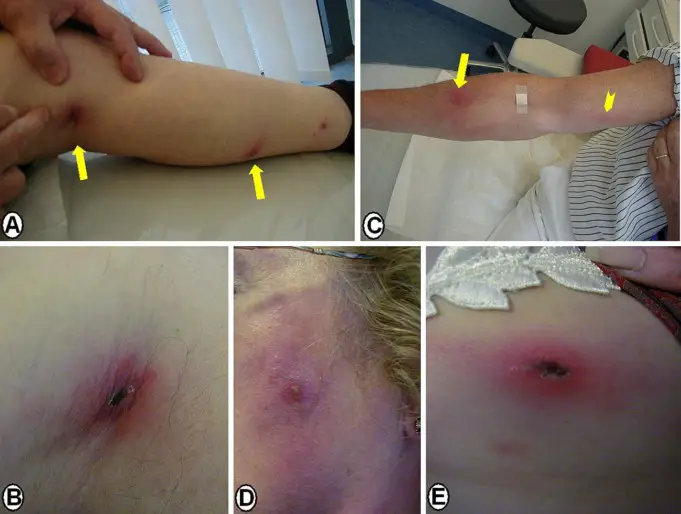The Africa tick-bite fever has been previously confused with Mediterranean spotted fever. The African Tick-bite fever is caused by a tick insect known as an Amblyomma.
This insect (Amblyomma) is native to tropical part, sub-Saharan Africa, some part of eastern Caribbean (French West Indies) and Oceania.
A bacterial infection caused by the Rickettsia africae bacteria affect these ticks and can be transmitted to animals when they feed on these animals, making it a tick-borne fever.
So, if you are a traveler that enjoys outdoor recreational activities like camping, jungle hiking, game hunting in bushy, wooded and grassy areas or a researcher of nature especially in these parts, it would be wise to take necessary precautions.
The African Tick-Bite Fever, which is also known as ATBF, otherwise known as the “tick borne spotted fever” is known to be a zoonosis type of infection- a type of infection that can be transmitted to humans by direct unprotected contact with livestock and wild animals.
But it cannot be transmitted from person to person.
Vector: The Amblyoma variegatum and Amblyomma hebraeum are the two most common species of hard ticks. They are the carrier of the bacteria (African tick-bite fever).
Typically, Amblyomma hebrarum transmit the bacteria in South Africa while Amblyoma variegatum carries Rickettsia africae throughout the West, Central and East Africa and through the French West Indies.
Note that the Africa ticks have its habitat among tall grasses, mast vegetation and bushes of rural areas.
Those at Risk of African tick-bite Fever (ATBF).
Ticks infected with Rickettsia bacteria that cause the tick-bite fever are usually most active during warm and rainy seasons from late periods of October through April.
So, travelers to sub-Saharan Africa and the West Indies may be of higher risk, so these travelers should take caution and preventive measures as slight mistakes as brushing against vegetation or walking in areas known to inhabit infected ticks that can lead to an infection.
What are the Symptoms of African tick-bite Fever?
The African Tick-Bite Fever (ATBF) has recently been discovered as one of the most important causes of flu-like illness.
It presents some common flu symptoms which appears 5 to 7 days after the bite from the tick but may last as long as 10 days and the symptoms often include:
- Fever
- Headache
- Myalgia
- Muscle soreness and severe skin inflammation
- Muscle rash (vesicular rash)
- Pain and a distinctive appearance known as an” Eschar” (a red sore with a dark dead centre) at the site of inoculation (bite site).
- Regional lymphadenopathy (swollen lymph nodes).
How to prevent African tick-bite Fever
Traveler that enjoys outdoor recreational activities like safaris, camping, jungle hiking, game hunting in bushy, wooded and grassy areas or a researcher of nature in these parts should take preventive measures like:
- Wear neutral colored and breathable garments including long-sleeved shirts and pants. Tuck in shirts, tuck parts into socks, and wear closed shoes instead of sandals to prevent tick bites.
- Use insect repellent containing at least 20% DEET for protection that lasts up to several hours, always reapply according to manufacturers direction. If you are also using sunscreen, apply sunscreen first and insect repellent second.
- If available, apply a permethrin spray or solution to clothing and gear (do not apply directly on skin).
- Avoid wooded and brushy areas with high grass, brush and leaves.
- Always walk in the center of hiking trails.
- Frequently carefully examine your body, clothing, gear and pets (if any) for ticks and if discovered, they should be handpicked and killed before entering a dwelling
- Make use of traps when sitting on the ground
- If any discovered bite site, thoroughly disinfect the bite site with soap and water or disinfectant.
- If a symptom of an African tick-bite fever develops, contact a healthcare practitioner immediately.
Diagnosis of African tick-bite Fever
Many patients of the African tick-bite fever who live in areas with a higher number of infections do not visit a doctor, only have mild symptoms. However, travelers that have never been exposed to this fever show more serious symptoms.
The antibiotic treatment available for African Tick infections has very few side effects, so if your medical practitioners and primary care givers suspects of the disease, he/she may simply treat without doing laboratory tests. But for confirmation, two tests are commonly used:
Blood tests
Common laboratory test signs of African tick-bite Fever (ATBF) are a low white blood cell count and low platelet count, a high C-reactive protein and mildly high liver function tests.
Microbiological tests
Biopsies or cultures of a person’s tick wound- eschar are used to diagnose African tick-bite Fever (ATBF). However, this requires special culture medium and can only be done by a laboratory with biohazard protection.
Treatments of African tick-bite Fever
The condition of the fever is usually mild, and most patients do not require more than home medication treatment with antibiotics for their illness. But because some patients visit their doctor, the best antibiotic choice, dose and length of treatment is not well known.
For mild cases, people are usually treated with one of the following:
- Doxycycline
- Ciprofloxacin
- Chloramphenicol
- Azithromycin
Conclusion
For more severe symptoms, the infection can be treated with doxycycline or azithromycin for a longer period of time. Primary care givers and dermatologists should know this clinical entity, since an inexpensive and efficient treatment is available as there is no vaccine for this infection.
Sources;
- Tick-Borne Rickettsioses; NCBI
- African tick-bite Fever; JAMA Network
- African tick bite Fever; NCBI












